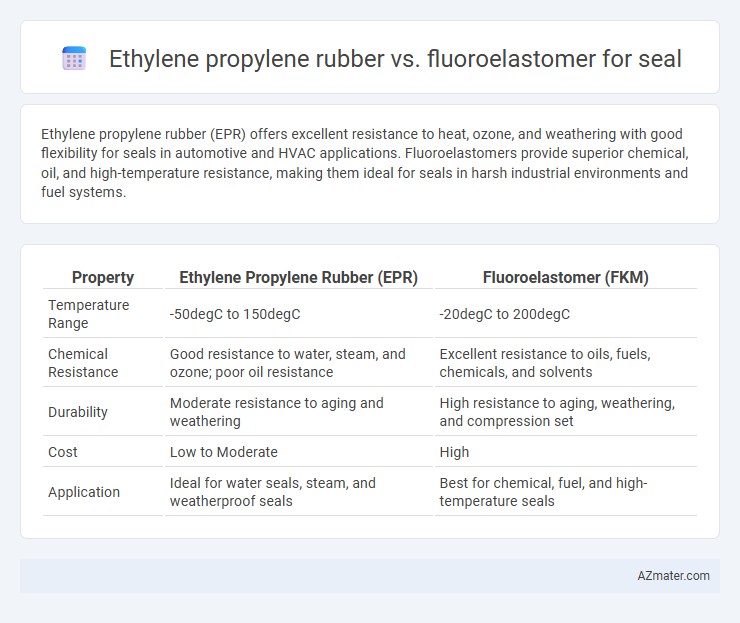Ethylene propylene rubber (EPR) offers excellent resistance to heat, ozone, and weathering with good flexibility for seals in automotive and HVAC applications. Fluoroelastomers provide superior chemical, oil, and high-temperature resistance, making them ideal for seals in harsh industrial environments and fuel systems.
Table of Comparison
| Property | Ethylene Propylene Rubber (EPR) | Fluoroelastomer (FKM) |
|---|---|---|
| Temperature Range | -50degC to 150degC | -20degC to 200degC |
| Chemical Resistance | Good resistance to water, steam, and ozone; poor oil resistance | Excellent resistance to oils, fuels, chemicals, and solvents |
| Durability | Moderate resistance to aging and weathering | High resistance to aging, weathering, and compression set |
| Cost | Low to Moderate | High |
| Application | Ideal for water seals, steam, and weatherproof seals | Best for chemical, fuel, and high-temperature seals |
Introduction to Ethylene Propylene Rubber and Fluoroelastomer
Ethylene Propylene Rubber (EPR) is a synthetic elastomer known for its excellent resistance to heat, oxidation, and weathering, making it ideal for seals in automotive and industrial applications. Fluoroelastomer (FKM) offers superior chemical and oil resistance, high-temperature stability, and exceptional durability, commonly used in aerospace and chemical processing seals. Selecting between EPR and FKM depends on the specific sealing requirements, including temperature range, chemical exposure, and mechanical stress.
Key Chemical Properties Comparison
Ethylene propylene rubber (EPR) exhibits excellent resistance to heat, ozone, and weathering due to its saturated polymer backbone, making it suitable for sealing applications in low to moderate chemical exposure environments. Fluoroelastomers (FKM) possess superior chemical resistance to fuels, oils, and aggressive chemicals, attributed to their fluorine-containing polymer chain, allowing operation at higher temperatures and in harsh chemical conditions. The key chemical difference lies in EPR's excellent resistance to polar solvents and oxidation, whereas FKM excels in resisting hydrocarbons and fluorinated chemicals, dictating their specific seal application suitability.
Performance in High-Temperature Environments
Ethylene propylene rubber (EPR) offers excellent resistance to heat, ozone, and weathering, maintaining flexibility and sealing integrity up to temperatures around 150degC, making it suitable for moderate high-temperature applications. Fluoroelastomers (FKM) excel in extreme high-temperature environments, tolerating continuous exposure up to 200-250degC with superior chemical resistance and low permeability, which ensures long-term durability in aggressive conditions. For sealing applications in high-temperature environments requiring exceptional chemical and thermal stability, fluoroelastomers outperform ethylene propylene rubber in maintaining seal performance and lifespan.
Resistance to Chemicals and Fluids
Ethylene propylene rubber (EPR) exhibits excellent resistance to a wide range of polar solvents, acids, and alkalis but has limited compatibility with hydrocarbons, oils, and fuels. Fluoroelastomers (FKM), on the other hand, demonstrate superior chemical resistance against aromatic and aliphatic hydrocarbons, oils, fuels, and aggressive fluids, making them ideal for harsh chemical environments. For applications requiring high-performance seals exposed to aggressive chemicals and fuels, fluoroelastomers provide significantly better durability and fluid resistance compared to ethylene propylene rubber.
Weathering and Ozone Resistance
Ethylene propylene rubber (EPR) offers excellent weathering and ozone resistance due to its saturated polymer backbone, making it suitable for prolonged outdoor applications in harsh environments. Fluoroelastomers (FKM) provide superior resistance to ozone and weathering, especially under extreme temperatures and chemical exposure, outperforming EPR in highly aggressive conditions. For sealing applications exposed to intense weathering and ozone, fluoroelastomer seals deliver enhanced durability and lifespan compared to ethylene propylene rubber.
Mechanical Strength and Flexibility
Ethylene propylene rubber (EPR) offers excellent flexibility and moderate mechanical strength, making it suitable for dynamic sealing applications requiring durability under deformation. Fluoroelastomers (FKM) provide superior mechanical strength with enhanced resistance to heat, chemicals, and wear, delivering long-term performance in harsh environments. While EPR excels in flexibility and low-temperature resilience, FKM seals are preferred when high mechanical stress and chemical exposure demand robust, high-strength materials.
Cost and Availability Considerations
Ethylene propylene rubber (EPR) offers a cost-effective sealing solution with widespread availability, making it ideal for general industrial applications. Fluoroelastomer (FKM) seals command higher prices due to advanced chemical and temperature resistance properties but are less commonly stocked, impacting lead times and accessibility. Budget-conscious projects with moderate environmental demands often favor EPR, while specialized applications requiring superior durability justify the premium cost of fluoroelastomers.
Application Suitability in Industrial Seals
Ethylene propylene rubber (EPR) offers excellent resistance to weathering, ozone, and water, making it suitable for sealing applications in water treatment plants and outdoor industrial environments. Fluoroelastomers (FKM) provide superior chemical resistance, high-temperature tolerance up to 200-250degC, and excellent compatibility with fuels, oils, and aggressive solvents, ideal for automotive, aerospace, and chemical processing seals. Choosing between EPR and fluoroelastomer depends on exposure conditions, with EPR favored for aqueous and environmental applications, while fluoroelastomers excel in harsh chemical and high-temperature industrial sealing scenarios.
Longevity and Maintenance Requirements
Ethylene propylene rubber (EPR) offers excellent resistance to weathering and ozone, providing a lifespan typically ranging from 10 to 15 years under moderate conditions, with minimal maintenance due to its stable chemical composition. Fluoroelastomers (FKM), known for superior chemical and temperature resistance, often exceed 20 years of service life in harsh environments, requiring less frequent replacements and reduced maintenance intervals. Selection between EPR and FKM for seals depends heavily on exposure factors, where FKM seals demonstrate higher longevity and lower maintenance needs in aggressive chemical or high-temperature applications.
Conclusion: Choosing the Right Elastomer for Seals
Ethylene propylene rubber (EPR) offers excellent resistance to weathering, ozone, and water, making it ideal for outdoor and water sealing applications. Fluoroelastomers (FKM) provide superior chemical resistance and high-temperature stability, suitable for harsh chemical environments and automotive seals. Selecting the right elastomer depends on specific environmental exposure and performance requirements, with EPR favored for general sealing and FKM preferred where extreme chemical and thermal resistance is critical.

Infographic: Ethylene propylene rubber vs Fluoroelastomer for Seal
 azmater.com
azmater.com